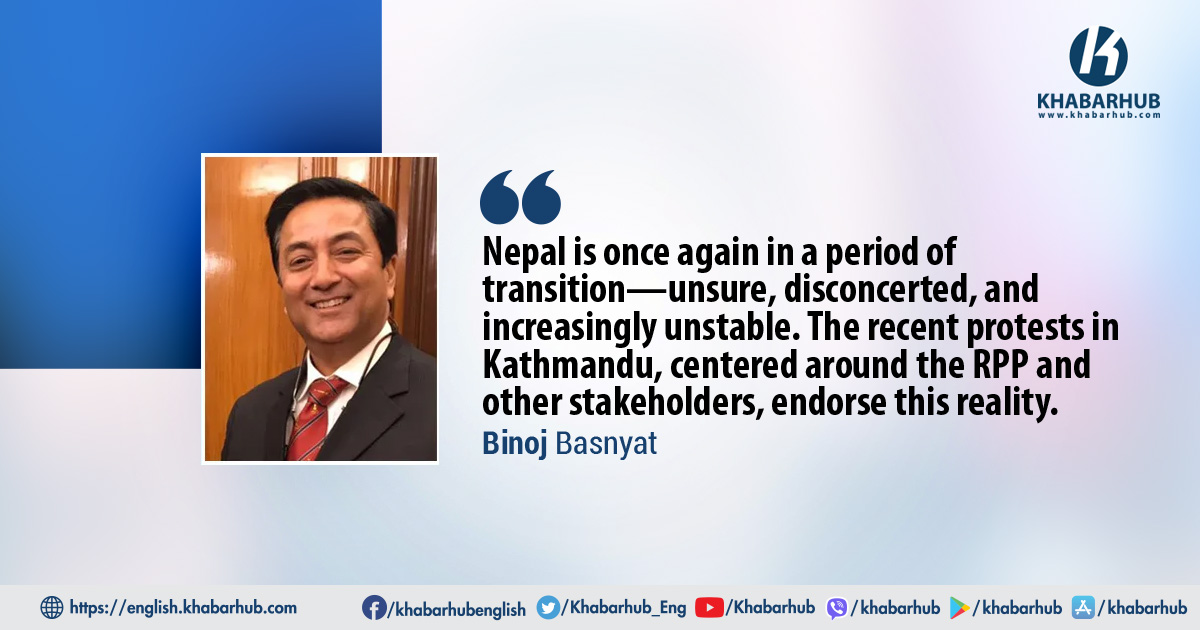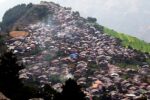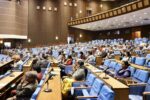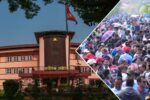Nepal is undergoing yet another test—this time polarizing society and politicizing the nation’s tools and institutions, with significant strategic implications.
The very idea of the nation-state is being questioned, particularly in the context of human rights and a sovereign Nepal, rather than through the lens of monarchists or republicans.
Uncovering the signal in the noise is a more appropriate approach than attempts to further polarize an already fragmented society. The crowd and slogans in the streets reflect the general sentiments of the people, which need to be acknowledged and validated.
Two key standpoints deserve attention: one concerning Nepal’s domestic political destiny, and the other relating to international relations and the regional shifts taking shape.
Regarding national interest, two global events serve as illustrative examples—the U.S. plan regarding Greenland as a protectorate, and Russia’s offensive in Ukraine.
Nepal can be viewed as a buffer state between China and India, both of which are rising powers with interests that may jeopardize Nepal’s sovereignty if the political leadership fails to address the ongoing domestic political and economic-security disorder, while simultaneously aligning with strategic shifts in South Asia and the Indo-Pacific.
Public discontent reflects deep dissatisfaction with governance and unmet aspirations for a better life. The issue is not about choosing between autocracy or democracy—it is about sustaining civil liberties, fundamental rights, and a functional democracy that serves the people.
From disinformation campaigns to induced migration, the challenges facing politicians, diplomats, and security authorities are interconnected and borderless.
Long-established political and diplomatic practices, entrenched in hierarchy and caution, often struggle to respond swiftly and effectively. Nepal stands at a critical juncture, where opportunities offer limited choices and even less time.
The Search for Functional Democracy
Nepal is in search of an “accountable, functional democracy” and a “credible nation,” while its citizens aspire for “good governance” that ensures justice, political participation, and national convenience.
The foundation of democracy lies within political parties, which lead national administration. However, the leadership at the helm of these parties—central to governance—urgently requires democratization.
The drafting of the 2015 Constitution, under significant political pressure, is among the root causes of Nepal’s political instability.
Equally important is the lack of post-conflict investment in developing a coherent “national behavior,” resulting in a disoriented “national character.” Much energy has been spent on political competition and justice/reconciliation efforts, rather than on promoting security and stability.
In a democracy rooted in sacrifice, values, and rule of law, Nepal cannot afford to remain a passive defender of an imperiled status quo governed by a “renegade order.”
The voices in the streets express collective frustration and disillusionment, while political party leaders remain unwilling to acknowledge entrenched national challenges.
Nepal risks a deepening crisis if this continues. Political instability cannot be resolved with the current model of governance—there can no longer be a “free ride” at Nepal’s expense.
Nepal’s political history resembles a game of musical chairs—14 governments in 17 years. Every time the music stops, a new party takes power, with no consensus on the rules.
After decades of monarchy, armed conflict, and coalition governments, the only constant seems to be leadership changes. The absence of pragmatism, long-term vision, and attention to India and China’s security concerns has left Nepal vulnerable.
An imposed peace is inherently flawed, sowing the seeds of future conflict. New political forces such as the Rastriya Prajatantra Party (RPP), Rastriya Swatantra Party (RSP), and various independents are pushing alternative political discourses.
Continuing to ignore public sentiment and aspirations will force some political leaders to pay a high price for geopolitical incompetence. Democracy could again be compromised, sacrificed at the altar of party interests.
Current Paradigms and Protest Movements
The events of March 28 have sparked both confusion and confidence. Two major protests occurred: one in support of restoring the monarchy and a Hindu state without federalism, and the other, led by the Socialist Unified Party, countered it in support of the secular federal republic.
Additionally, the Prachanda-led faction raised concerns over the non-functioning parliament and opposed the removal of Kulman Singh Ghising, CEO of the Nepal Electricity Authority (NEA), citing corruption and government ineffectiveness.
On April 8 (26 Chaitra), the anniversary of democracy restoration, Kathmandu witnessed a convergence of multiple protests. The Confederation of Nepal Teachers (CNT) continued a peaceful protest demanding a student- and teacher-friendly School Education Act, calling it the “final and decisive movement” for educational reform.
Simultaneously, resident doctors at Nepal Medical College protested against the commercialization and politicization of medical education, including the black marketing of postgraduate seats and labor exploitation.
There are three dominant positions: one in support of the federal secular republic system; the second calling for changes in the political structure; and the third advocating for a constitutional or ceremonial monarchy with an elected Head of Government and a multiparty democracy.
Another major protest demands the reinstatement of Kulman Ghising as NEA’s executive director. After being denied an interim order by the Supreme Court, his supporters have taken to the streets.
Meanwhile, the Rastriya Prajatantra Party (RPP), backed by the Joint People’s Movement Committee (JPMC), rallied for the restoration of the Hindu state, a constitutional monarchy, a directly elected prime minister, and the abolition of federalism.
Similarly, Rastriya Janamorcha continued its protests, advocating for the elimination of federalism while preserving the republic and nationalism.
Lastly, Durga Prasai, of the Nagarik Bachau Abhiyan, remains in hiding after leading a violent pro-monarchy march on March 28, promoting nationalism, religion, culture, and citizen protection.
Public discontent reflects deep dissatisfaction with governance and unmet aspirations for a better life. The issue is not about choosing between autocracy or democracy—it is about sustaining civil liberties, fundamental rights, and a functional democracy that serves the people. Nepal’s strategic future hinges on addressing institutional corruption, delivering responsive governance, reducing elite capture, and halting unchecked migration.
The aim must be to empower citizens at home and avoid slipping into spheres of foreign influence.
Ultimately, it’s about safeguarding Nepal’s sovereignty, restoring integrity, and achieving the long-awaited strategic stability the people have been hoping for over nearly two decades.
After Prime Minister KP Oli’s Address in Parliament on 31 March – A Foundational Question Arises:
Is the core issue Nepal’s political system itself, or is it the hesitation and fear among orchestrators and front-runners of political parties of being held accountable, which prevents them from addressing national challenges?
There is rising anger over corruption and disillusionment with politics, while polarization of thought prevails.
With democracies across South Asia and the globe under strain, Nepal appears to be seeking a fundamental shift from the “new normal” that began in 2006 and concluded in 2015—to stand as an example of democratic resilience.
There are three dominant positions: one in support of the federal secular republic system; the second calling for changes in the political structure; and the third advocating for a constitutional or ceremonial monarchy with an elected Head of Government and a multiparty democracy.
Strategic Considerations and Future Pathways
Three political environments and forces are currently competing, seeking electoral alliances and coalition partners, all while fearing each other. These include:
The constitutional forces – primarily the Nepali Congress (NC) and the Communist Party of Nepal (Unified Marxist-Leninist or UML).
The constituted forces – such as the Madhesi-based political parties and the Nepal Communist Party (Maoist Centre).
The newly constituted forces – including the Rastriya Swatantra Party (RSP) and Independent candidates, who are gaining popularity in urban areas.
In addition, the Rastriya Prajatantra Party (RPP) is carving out its own space in the political arena.
Two major strategic tensions are emerging. First, constitutional and constituted political forces are competing both in parliament and in the streets, with little regard for delivering justice to the people.
Second, some parties are using nationalism—often veiled in anti-India rhetoric and populism—as a means to gain electoral power, which serves no purpose for Nepal’s strategic priorities or long-term stability.
Nepal arguably would have been more peaceful had arms not been raised against democracy when pluralism was the only approach. Secondly, it might have been more united and developed without adopting federalism.
Thirdly, international aid—whether grants, soft loans, or loans—would have been better utilized for national priorities instead of promoting federalism.
Fourth, a smaller and more accountable political system could reduce political exploitation while increasing justice, democracy, and human rights.
Lastly, one must ask: Is there a viable alternative for Nepal’s political stability and national credibility, or must we continue with an ineffective system while the region undergoes rapid transformation?
In short: Nepal is once again in a period of transition—uncertain, unsettled, and increasingly unstable. Recent protests in Kathmandu by the RPP and other stakeholders underscore this reality.
For now, the processes implemented by the Oli-led coalition may offer temporary relief.
However, the situation is fluid and may change quickly. The three main political parties (NC, UML, and the United Socialist Party), along with the RSP and RPP, should form a strategic task force, chaired by individuals with creative vision, to help the country address immediate uncertainties, build resilience, and adapt to the changing political, economic, and security landscape.
The only way forward is for Nepal to remain united—pooling national resources and committing to resolve its internal challenges. The two largest parties, in particular, must take responsibility for steering Nepal through these turbulent times, ensuring that no one is left behind.
Nepal’s desire for a “functional democracy” and a “credible nation” has yet to be fulfilled. The current indecisiveness—rooted in governance driven by greed and a fear of accountability—will only lead to more confusion and delay.
Moving forward, Nepal must unite its diverse voices while ensuring that democracy, justice, and development remain central to its national agenda.
Nepal must keep its political doors open, its economy accessible, its institutions depoliticized and strong, and its citizens cohesive—wherever they may be.
Conclusion: A Call for Collective Action
With democracies across South Asia and the globe under strain, Nepal appears to be seeking a fundamental shift from the “new normal” that began in 2006 and concluded in 2015—to stand as an example of democratic resilience.
The alternative must be a new beginning—government of the people, by the people, for the people. This must be envisioned and realized in Nepal, by Nepal, and for the Nepalese.
The ball is now in the Oli-led administration’s court. It must chart a peaceful way forward as a coalition or alliance. The 2084 (BS) election may not be the right response to such deeply rooted uncertainty.
Otherwise, we risk another wave of unrest—a heavy silence hanging in the air, a tide of change approaching to sweep away the familiar and replace it with the unknown.
Though Nepal’s institutions have held up reasonably well, the growing unrest highlights the mounting pressure on its democracy—and the looming prospect of future crises.
Nepal must not place all its geopolitical eggs in the fragile basket of the “unreformed federal secular republic.” Political leadership must remain accountable.
Nepal cannot remain the same, especially when political options and alternatives exist. The way forward lies in “constitutional reform for a functional democracy.”
Nepal has few choices, and the Nepali people face limited possibilities. As diplomacy transforms, so too must Nepal’s future leaders in a world shaped by pandemics, wars, climate disruption, and technological upheaval. Today’s political leaders and diplomats must be more than guardians of protocol—they must be problem-solvers, bridge-builders, and innovators shaping Nepal’s strategic future.
Among the political reforms urgently required:
Eliminate the proportional representation system, reducing parliament to 110 members.
Ensure the elected Head of Government or State selects an executive team based on expertise, not just legislative affiliation.
Scrap federalism in favor of strong local political bodies or sub-national diplomacy.
Amend the approach to secularism in order to preserve Nepal’s identity.
Ensure the Legislature upholds constitutional accountability.
Encourage political parties to embrace internal democratization and agility in decision-making, even under resource constraints—leveraging innovation and speaking to both policy and people.
The international community—particularly Beijing, Delhi, and friendly democracies—must take note.
The success of Nepal’s political transformation depends on the ability of its two main political leaders to facilitate dialogue among stakeholders, address legitimate grievances, and create a political environment conducive to cooperation and progress.
Moving forward, Nepal must unite its diverse voices while ensuring that democracy, justice, and development remain central to its national agenda.
The calm after the storm is not the solution. Only political will, with legitimate action, is the remedy.
(The author is a Strategic Analyst, Major General (Retd) of the Nepali Army, and is associated with Rangsit University, Thailand)









Comment